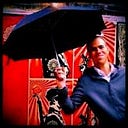A while ago, I described how imagining new characters could help us better understand how we could navigate uncertain futures.
“People naturally look for characters they can identify with. They have the power to personalize the story and deepen our connection with a particular issue.”
We’ve repurposed the segmentation used in “People Make Places” made for local residents as a way of foreshadowing the creative civic citizen. What type of changemaker are you?
Armchair activists
Prefer to be card carrying members of organisations or sign petitions online because they don’t yet feel comfortable or powerful enough to shape the issues they’re campaign on. Organisations like 38 Degrees or Hope not Hate are the best examples of getting “armchair activists” to take part in real life campaigns like “saving the forests” while social reporters capture the stories from the field to take into people’s homes.
Brand addicts
Prefer campaigning for high profile initiatives so they can be associated with symbols of success. They enjoy activities which don’t require too much effort but allow them to show others how they have been involved in winning change. Organisations like Comic Relief provide the bridge for “brand addicts” to get involved in crunchier causes like the Robin Hood Tax, while Battlefront get young “bright lights” linked up to celebrities to get “brand addicts” to support them.
Bright lights
Prefer campaigning in innovative groups or new issues — often outside their neighbourhood as they enjoy meeting like minded people. They are comfortable with disruptive techniques like direct action and may themselves shift accepted approaches on campaigning. Groups like War on Want use a range of methods to keep “bright lights” excited and productive on campaigns like Love Fashion Hate Sweatshops.
Coalition builders
Prefer to campaign on issues than for just one organisation. They can bring new ideas and energy to campaigns but can also be associated with breaking the rules. They can appear anywhere as their purpose is to organise different campaigns at the same time. They can be guerrilla-like, finding niche issues or activities to make their own. Coalitions like Post Bank enable “coalition builders” to come together to campaign on symbolic issues like turning the post office into a post bank.
Community organisers
Prefer getting involved in campaigning around where they live because they want to be in familiar surroundings and campaign on what affects the people around them. Groups like London Citizens or Locality train people from their member organisations to make sure they can lead their communities to hold decision makers to account, while Talk About Local give people a voice to get their neighbours do that online.
Hobby horses
Prefer getting involved in workshops or community activities because they want to try and learn as much as possible as much for social reasons as the training itself. Initiatives like Transition Towns build the capacity for “hobby horses” to affect structural change in communities like with the Brixton Pound as does Social Spaces with The Open Works.
Tribalists
Prefer getting involved in the organisation they’ve always been a member of because they want to be proud of their loyalty and commitment to a greater cause than a single issue. Some may focus on hard wiring the historic values of their organisation into new members, while others will look to recruit new faces from other communities or movements because they believe that organisation will provide that united front.
Public spirits
Prefer organising people for campaigning on the streets because they are looking for something more profound and enjoy intervening at a large scale. Movements like the “Indignados” create spaces for groups to self-organise in a consensus-based collective.
Creative Safarians
Prefer getting involved in different organisations on the issue they really care about because they take pride in knowing their issue and wanting to share knowledge about it with others. Issues like fair trade cross over various types of community, campaigning and entrepreneurial activities to provide a common thread for “safarians” to stay involved whatever the environment they’re in. This group is the biggest threat to hierarchical campaigning organisations, but equally the biggest opportunity for creative activism as they bring lessons from unlikely places which produces creative tensions and disruptions that help reframe old issues through fresh perspectives.
Which type of changemaker are you?
What types of change do you help grow & support?
What types of change are missing?
